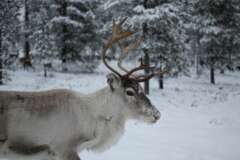Climate change might even drive widespread mammal species to extinction
Wide-spread land mammal species are not off the hook when it comes to negative effects of climate change, a new study by researchers from the Senckenberg Biodiversity and Climate Research Centre just published in Ecology Letters shows. The authors found that next to climatic tolerance, the size of the area where a land mammal species can be found depends on how flexible the species is with respect to its habitat. In contrast, the range of its diet is not reflected in species range size — even wide-spread species might have specialized diets. If climate change or human activities diminish their preferred resources, many wide-spread yet specialized species will be prone to extinction.
In the face of ongoing global change, understanding why some species are particularly vulnerable to extinction is of critical importance. To answer this question, extensive investigation has been focused on the link between the current geographic distribution of species and the range of climatic conditions under which they can survive and reproduce to sustain viable populations. However just being geographically wide-spread and therefore to “feel fine” with even a non-subtle change in temperature (i.e. being a thermal generalist) might not give a species the all-clear. “Wide-spread species are not necessarily generalists in every way or tolerant of all kinds of environmental changes”, says Dr. Shan Huang, a postdoctoral researcher at the Senckenberg Biodiversity and Climate Research Centre (SBiK-F).
Her statement comes as the conclusion of a study in which she and her team looked at how the variety of biotic resources for a species to persist, i.e. its ecological niche breadth, is reflected in the range size of animals at the individual as well as the species level. To do this they investigated 543 species of land mammals. Their average individual home range size as well as species range size, i.e. the collective distribution range of all individuals belonging to the same species, were compared with data on the species’ habitat range and diet breadth. The habitat range represents in how many types of different habitats a species can live in and diet breadth represents how many different types of foods a species consumes.
“The factors that matter for the average individual home range size and the total species range size are completely different”, Huang sums up the main finding. The analysis shows that where an individual mammal roams is mainly related to how diverse the species’ preferred diet is and its body size which determines its food requirements and its ability to forage over large areas.
The species geographic range size however is not related to its diet breadth or body size, but to the variety of habitats where the species is occurring. This is a reflection of its ability to persist under various environmental conditions, so that less picky species tend to be more widespread. The authors interpret the finding of the different relationships as a sign of differential ecological and evolutionary dynamics driving the range dynamics at the individual and species level.
Therefore, “Land mammal species that are wide-spread might be able to tolerate a larger variety of environmental conditions – such as climatic conditions or habitat type – but they are not necessarily capable of using a larger variety of food resources. Many widely-distributed species have specialized diets and thus may still be prone to extinction when climate change and human activities reduce the availability of their foods in their preferred habitats”, states Huang in conclusion. Finally, the study also highlights that there is a pronounced difference between the ability of a species and that of a species’ individuals to tolerate environmental changes.
Publication: Huang, S. et al. (2021) : Scale dependent effects of niche specialisation: the disconnect between individual and species ranges. Ecoloy Letters, doi: 10.1111/ele.13759

